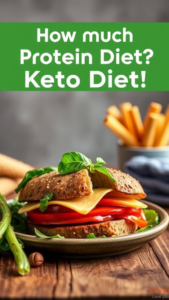Optimal Protein Intake for Your Keto Diet
Understanding how much protein to include in your keto diet is essential for maximizing health benefits and achieving your weight loss goals. Protein plays a crucial role in building and repairing tissues, making hormones, and fighting infections. On a keto diet, the goal is to maintain ketosis, a metabolic state where your body burns fat for fuel instead of carbohydrates.
The optimal protein intake can vary based on individual factors such as age, sex, physical activity level, and overall health. Generally, on a ketogenic diet, protein intake should be moderate as too much protein can hinder ketosis. Often, a range of 20-25% of total daily calories from protein is considered ideal. However, let’s break this down further to make it clearer.
Calculating Your Protein Needs
Your protein requirement can be calculated based on your body weight and activity level. Here’s how:
- Determine Your Weight: First, calculate your body weight in kilograms (kg). For example, if you weigh 70 kg, that will be your starting point.
- Multiply by Activity Factor: Depending on your activity level, multiply your weight by the following factors:
- Sedentary (little to no exercise): 1.0
- Lightly active (light exercise/sports 1-3 days a week): 1.2
- Moderately active (moderate exercise/sports 3-5 days a week): 1.4
- Very active (hard exercise/sports 6-7 days a week): 1.6
- Super active (hard daily exercise or physical job): 1.8
- Find Your Protein Intake: Once you have your multiplier, the recommended protein intake for ketosis is around 1.0 to 1.5 grams of protein per kilo of body weight. For example, if you decide to go with 1.2 grams of protein for your 70 kg weight, the calculation would be:
70 kg x 1.2 g = 84 grams of protein per day.
Understanding the Importance of Protein Timing
The timing of your protein intake can also affect your keto diet results. Here are a few tips:
- Distribute Your Protein: Aim to spread your protein consumption throughout the day. Having protein at each meal helps maintain muscle mass and keeps you feeling satisfied.
- Post-Workout Nutrition: If you exercise regularly, consider having protein-rich foods after workouts to aid muscle recovery.
- Evening Protein: Consuming protein in the evening can promote satiety, helping you avoid late-night snacking.
Protein Sources for Your Keto Diet
Choosing the right sources of protein is just as crucial as determining how much you need. Here are some keto-friendly options:
| Food Source | Protein per 100g | Net Carbs per 100g |
|---|---|---|
| Chicken Breast | 31g | 0g |
| Salmon | 25g | 0g |
| Eggs | 13g | 1g |
| Ground Beef (80% lean) | 26g | 0g |
| Tofu | 8g | 1g |
| Greek Yogurt (full-fat) | 10g | 4g |
These protein sources into your meals can ensure you’re meeting your daily protein targets while maintaining low carb levels. Remember, it’s essential to focus on quality protein. Opt for grass-fed, organic, and sustainably sourced options whenever possible.
Monitoring Your Progress
As you embark on your keto journey, keeping track of your protein intake is crucial. Consider using apps or food journals to log what you eat. This will help you stay within your protein goals and adjust based on how your body responds. By listening to your body, you can find the optimal balance that keeps you in ketosis while feeling energized and satisfied.
Finding the right protein intake for your keto diet may take some trial and error. Focus on your calculations, stay consistent with your choices, and enjoy the process of discovering what works best for you!
The Role of Protein in Ketosis
The ketogenic diet primarily focuses on reducing carbohydrate intake while increasing fat consumption. A vital nutrient in this process is protein, which plays a significant role in achieving ketosis. Understanding how much protein to include in your diet can help you maintain this metabolic state and reach your health goals effectively.
Protein serves multiple functions in the body, especially for those on a ketogenic diet. Here are some key roles it plays:
- Muscle Maintenance: Adequate protein intake helps maintain muscle mass, which can be particularly important when you’re losing weight.
- Satiety: Protein keeps you feeling full longer, which can help curb cravings and reduce overall calorie intake.
- Bodily Functions: Protein is essential for the repair of tissues and the production of enzymes and hormones.
When transitioning to a keto lifestyle, it’s crucial to find the right balance of macronutrients. While the diet is high in fats, the question arises: how much protein should you consume? Generally, it is recommended to keep protein moderate because excessive protein can convert into glucose through a process called gluconeogenesis, which may hinder ketosis.
Most experts suggest that your protein intake should range between 15% to 25% of your total daily caloric intake. Here’s how to calculate it:
- Determine your daily caloric needs. This can vary based on age, gender, weight, and activity level.
- Multiply your daily calorie intake by 0.15 to 0.25 to find the protein calorie range.
- Since each gram of protein contains 4 calories, divide the outcome by 4 to get the recommended protein in grams.
For example, if your total daily calorie requirement is 2000 calories:
- 15%: 2000 x 0.15 = 300 calories from protein → 300 / 4 = 75 grams
- 25%: 2000 x 0.25 = 500 calories from protein → 500 / 4 = 125 grams
This means your daily protein intake should range between 75 to 125 grams based on a 2000 calorie diet. Individual needs may vary, so it is crucial to listen to your body and adjust accordingly. Several factors influence how much protein you should eat on a keto diet:
- Activity Level: If you are physically active, especially in resistance or endurance training, you might need a higher protein intake for muscle recovery.
- Body Composition Goals: If you aim to build muscle, closer to 25% of your total calories might be beneficial. Conversely, if weight loss is the primary goal, sticking to around 15% could help.
- Age: Older adults may require more protein to maintain muscle mass and strength, even on a low-carb diet.
It’s essential to choose high-quality protein sources. Ideal protein options on a ketogenic diet include:
- Animal-based proteins like meat, fish, and eggs
- Dairy products such as cheese and Greek yogurt
- Plant-based proteins in moderation, like nuts and seeds
Monitoring your protein intake can be easily managed with various apps or food diaries, ensuring you stay within your recommended range. Remember to adjust your protein based on your personal needs and experiences, as everybody can react differently to dietary changes.
The role of protein in the ketogenic diet is multifaceted. It helps maintain muscle mass, keeps you satiated, and aids in numerous bodily functions. Finding the right protein level on your keto journey is imperative for ensuring you remain in ketosis while reaching your weight loss or muscle gain goals. Always evaluate your individual requirements and adjust your protein consumption accordingly for optimal results.
Balancing Macronutrients: Protein, Fat, and Carbs on Keto
When you embark on a ketogenic diet, understanding how to balance macronutrients—protein, fat, and carbohydrates—is crucial for achieving your health and weight loss goals. The keto diet primarily emphasizes high fat intake, moderate protein, and very low carbohydrates. This unique macronutrient distribution helps your body enter and maintain a state of ketosis, where fat becomes the main energy source.
To effectively follow a keto diet, it’s essential to know how much protein, fat, and carbs you should be consuming. Let’s break them down to help you find the right balance for your needs.
Understanding Macronutrient Ratios on Keto
Most people on a ketogenic diet may aim for the following macronutrient ratios:
- Fat: 70-80% of total daily calories
- Protein: 20-25% of total daily calories
- Carbohydrates: 5-10% of total daily calories, typically between 20-50 grams per day
These ratios can vary based on individual factors such as activity level, body composition, and health goals. Understanding these percentages helps you make informed dietary choices.
How Much Protein is Ideal on Keto?
When it comes to protein, many individuals have questions about how much is appropriate. Since the keto diet is not a high-protein diet, but rather a moderate one, it’s essential to strike the right balance.
A good rule of thumb is to calculate your protein needs based on your body weight. Here’s a simple approach:
- Multiply your ideal body weight (in pounds) by 0.6 to 1.0 grams of protein.
This means that if you weigh 150 pounds, you might aim for 90 to 150 grams of protein daily, depending on your specific goals and lifestyle. If you’re more active or trying to build muscle, you might target the higher end of the range.
Protein Sources for the Keto Diet
Choosing the right protein sources is equally important. Here’s a list of keto-friendly protein sources:
- Meat: Beef, pork, lamb, and chicken
- Fish: Salmon, sardines, and mackerel
- Eggs: A versatile protein option
- Dairy: Cheese, yogurt, and sour cream (opt for full-fat)
- Nuts and Seeds: Almonds, chia seeds, and walnuts
Including a mix of these protein sources helps ensure you’re getting essential amino acids while also enjoying a variety of flavors and textures.
Balancing Fat Intake
Fat is the cornerstone of the keto diet. Fats should constitute the majority of your daily caloric intake. Healthy fats include:
- Avocados
- Olive oil and coconut oil
- Butter and ghee
- Fatty fish and nuts
These fats not only support ketosis but also provide essential fatty acids that your body requires. Moreover, they keep you satiated and help curb hunger, making it easier to stick to this diet.
The Role of Carbohydrates
Limiting carbohydrates is key to maintaining ketosis. Focus on low-carb vegetables and avoid grains, sugary foods, and starchy vegetables. Typical low-carb vegetables include:
- Spinach and kale
- Broccoli and cauliflower
- Asparagus and zucchini
Keeping your daily carbohydrate intake between 20 to 50 grams will help your body stay in a state of ketosis and effectively burn fat for fuel.
Finding Your Balance
In the end, the balance of protein, fat, and carbs will vary with each individual. It’s beneficial to track your macronutrient intake using apps or food diaries until you become familiar with your eating patterns. By doing so, you can tweak your portions as needed to meet your goals without compromising the state of ketosis.
Remember, everyone’s body responds differently to dietary changes. Therefore, it’s always wise to adjust your intake according to your body’s signals. Regular check-ins and possibly consulting with a healthcare professional can also help guide you on your keto journey.
Finding the perfect balance of macronutrients on the keto diet allows you to enjoy a fulfilling eating experience while reaching your health goals effectively. Keep refining your approach, and listen to your body’s needs!
Best High-Protein Foods for the Keto Diet
Are you following a keto diet and wondering about the best high-protein foods to include? High-quality protein sources can help keep you in ketosis while also supporting muscle maintenance. Below, we will explore various protein-rich foods perfect for your keto lifestyle.
Meat and Poultry
Meat is a fantastic source of protein on a keto diet. Here are some options:
- Chicken Breast: A lean source of protein that is versatile and low in carbs. A 3-ounce serving has about 26 grams of protein.
- Ground Beef: Offers a good amount of dietary fat which makes it ideal for keto. A 3-ounce portion has around 22 grams of protein.
- Pork Chops: With about 26 grams of protein per 3 ounces, pork chops are satisfying and delicious.
- Turkey: Ground turkey is a lean choice, providing about 24 grams of protein in a 3-ounce serving.
Fish and Seafood
Fish and seafood are not just healthy but also low in carbs. Here’s what you should consider:
- Salmon: Rich in omega-3 fatty acids and packed with protein, salmon offers about 22 grams of protein in a 3-ounce serving.
- Tuna: A great source of protein, offering around 20 grams per 3-ounce serving. Canned tuna is convenient and easy to use.
- Shrimp: Low in calories and high in protein (about 20 grams per 3 ounces), shrimp is a fantastic keto food option.
Dairy Products
Some dairy products are not only rich in fats but also provide a healthy protein boost:
- Greek Yogurt: Opt for full-fat versions. A 6-ounce serving has about 15 grams of protein.
- Cheese: Cheese can vary, but varieties like cheddar offer about 7 grams of protein per ounce.
- Cottage Cheese: Low in carbs and high in protein, with around 14 grams of protein per half-cup serving.
Nuts and Seeds
Nuts and seeds are excellent for snacking while providing protein and healthy fats:
- Almonds: A 1-ounce serving offers about 6 grams of protein.
- Chia Seeds: A great source of fiber and protein, with about 5 grams of protein per 2 tablespoons.
- Pumpkin Seeds: They provide around 8 grams of protein per 1-ounce serving, making them a nutritious snack.
Eggs
Don’t overlook eggs! They are a staple in the keto diet:
- Whole Eggs: A powerhouse of nutrients, one large egg contains about 6 grams of protein. They can be prepared in numerous ways and are incredibly versatile.
Protein Supplements
If you find it hard to meet your protein needs through food, protein supplements can be a good option:
- Protein Powders: Look for low-carb options like whey, casein, or plant-based powders. They often contain about 20-25 grams of protein per scoop.
- Collagen Peptides: Though not a complete protein, collagen can enhance your overall protein intake and improve skin health. It’s typically around 9 grams of protein per serving.
Sample Protein Content Table
| Food Item | Protein (per 3 oz) |
|---|---|
| Chicken Breast | 26 grams |
| Ground Beef | 22 grams |
| Salmon | 22 grams |
| Shrimp | 20 grams |
| Whole Eggs | 6 grams (per egg) |
To succeed on your keto journey, integrate these high-protein foods into your meals. Not only will they support your dietary needs, but they will also keep your meals exciting and varied. Remember that achieving a balance of protein within your macro goals can help you feel satisfied and energized throughout your day!
Common Mistakes in Protein Consumption While on Keto
Many people turn to the keto diet for weight loss and health benefits, but some common mistakes in protein consumption can hinder their success. Understanding how to effectively manage protein intake on the keto diet can make a significant difference in achieving your goals.
One of the first mistakes is not consuming enough protein. While the keto diet is low in carbohydrates and high in fats, protein is still an essential macronutrient that helps with muscle maintenance and repair. A good rule of thumb is to aim for around 15-25% of your daily caloric intake from protein. This typically translates to about 0.6 to 1.0 grams of protein per pound of lean body mass.
Another common error is consuming too much protein. While protein is important, excessive amounts can kick you out of ketosis. When consumed in high quantities, the body can convert protein into glucose through a process called gluconeogenesis. This can disrupt the metabolic state of fat burning that the keto diet aims for. Stick to recommended protein levels to maintain your keto state effectively.
Some individuals may also overlook the quality of protein sources. Not all protein is created equal. Processed and low-quality protein sources often contain added sugars or unhealthy fats that can sabotage your progress. Focus on high-quality proteins like:
- Grass-fed meats
- Wild-caught fish
- Pasture-raised eggs
- Nuts and seeds
These options not only ensures you get sufficient protein but also provides your body with essential nutrients.
Lack of variety can lead to boredom and nutritional deficiencies. Eating the same few protein sources repeatedly can limit your intake of essential vitamins and minerals. Instead, try to include a range of proteins in your diet. Experiment with different meats, seafood, and plant-based proteins to keep your meals exciting and nutritious. For instance, consider adding:
- Chicken, turkey, and lamb
- Shrimp, salmon, and tuna
- Tofu, tempeh, and legumes (in moderation)
Portion control is another aspect where mistakes often occur. Many people assume that as long as they’re on the keto diet, they can eat large portions of protein without consequence. However, being aware of serving sizes is crucial. Referencing common portion sizes can help you manage intake effectively. For example:
| Protein Source | Serving Size | Protein Content |
|---|---|---|
| Chicken breast | 3 ounces | 25 grams |
| Salmon | 3 ounces | 22 grams |
| Eggs | 1 large | 6 grams |
Additionally, staying hydrated is vital but often overlooked. Many people focus solely on macronutrients while neglecting adequate water intake. Proper hydration aids digestion and helps with the absorption of proteins. Aim to drink at least half of your body weight in ounces of water daily to support your overall health and optimize protein utilization.
Don’t forget about timing! Some people emphasize protein intake only at one meal, neglecting to distribute it throughout the day. Spreading your protein consumption across multiple meals helps maintain muscle synthesis and keeps you satiated. Consider planning your meals to include a source of protein at breakfast, lunch, and dinner to maximize benefits.
Navigating protein consumption on the keto diet requires attention to several factors. By avoiding these common mistakes, you can effectively manage your protein intake, support your health, and stay in ketosis. Remember, the keto diet is not just about low carbs; it’s about finding that perfect balance of macronutrients that works for your body.
Conclusion
Finding the right balance of protein on the keto diet is crucial for maximizing your results while enjoying the benefits of ketosis. Understanding optimal protein intake allows you to tailor your diet effectively, ensuring you’re fueling your body without kicking yourself out of ketosis. Remember, protein plays a vital role in ketogenesis, helping you maintain muscle mass while burning fat.
As you navigate the world of keto, it’s important to balance your macronutrients wisely. This means not only focusing on getting in enough protein but also including healthy fats and limiting your carbohydrate intake. By doing so, you create a sustainable eating pattern that encourages fat loss and better energy levels.
A variety of high-protein foods into your meals can make your keto journey more enjoyable. Incorporate options like fatty cuts of meat, eggs, and certain dairy products to meet your protein needs without exceeding carb limits. However, be mindful of common pitfalls—overconsumption or underconsumption of protein can hinder your progress.
By educating yourself on the nuances of protein consumption within a keto framework, you can avoid these mistakes and enhance your overall experience. The right protein strategy helps you achieve your weight loss goals while still feeling satisfied and energized. Keep experimenting, stay informed, and listen to your body’s needs, and you’ll set yourself up for long-term success on the keto diet.




